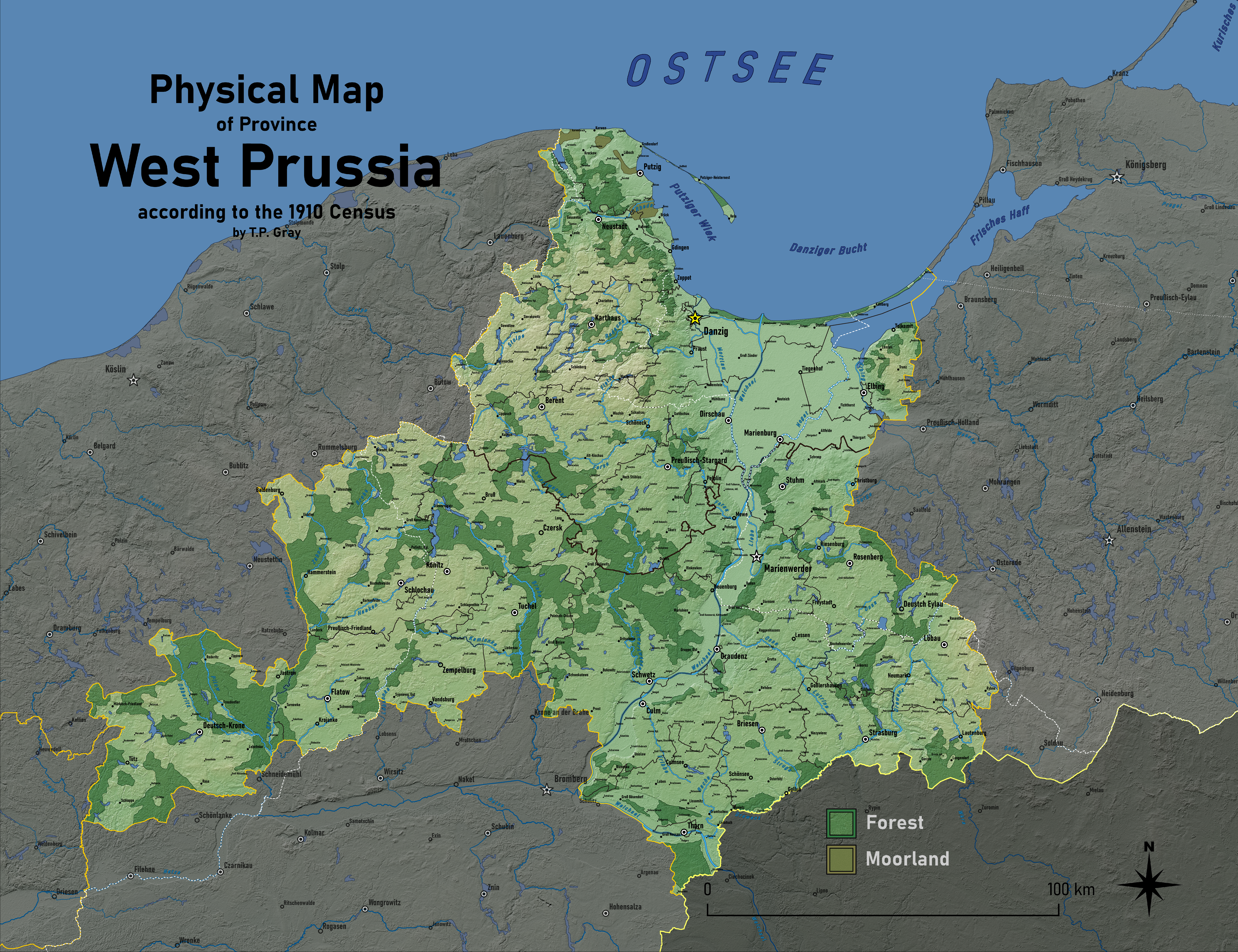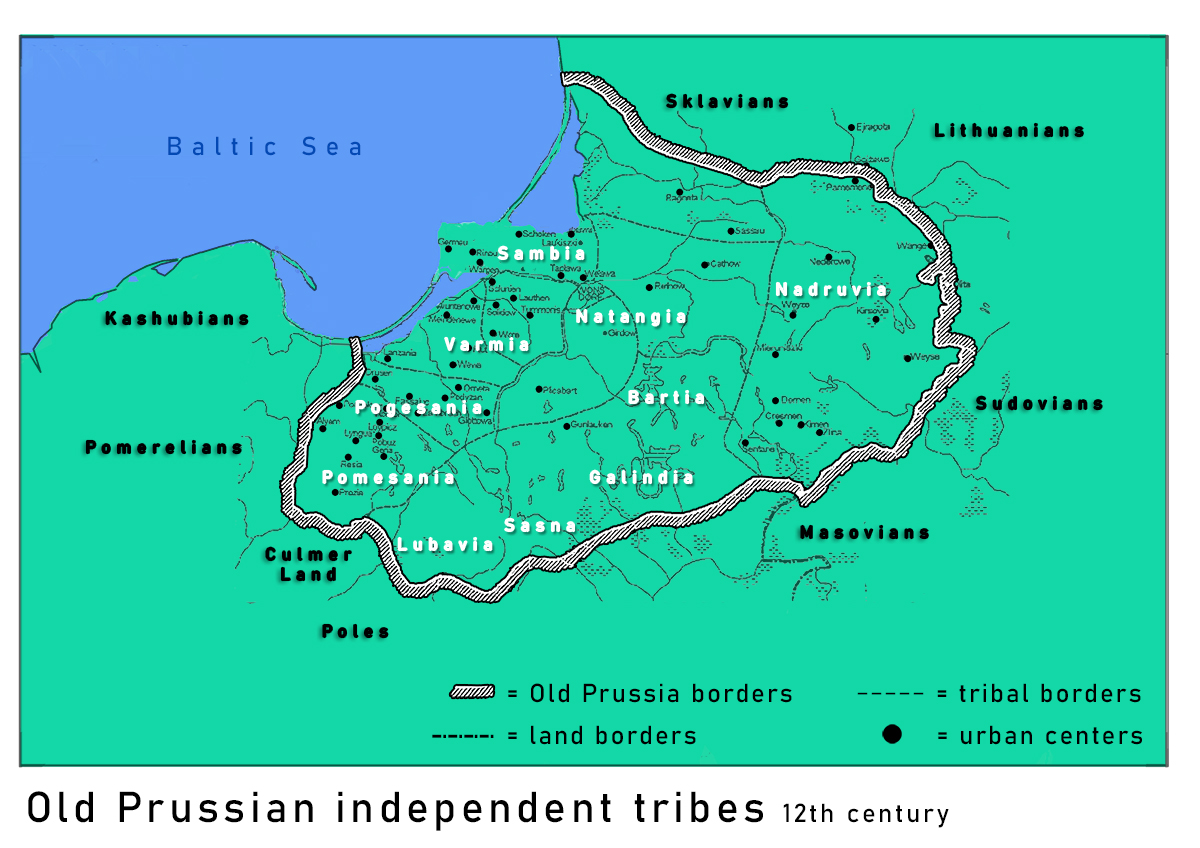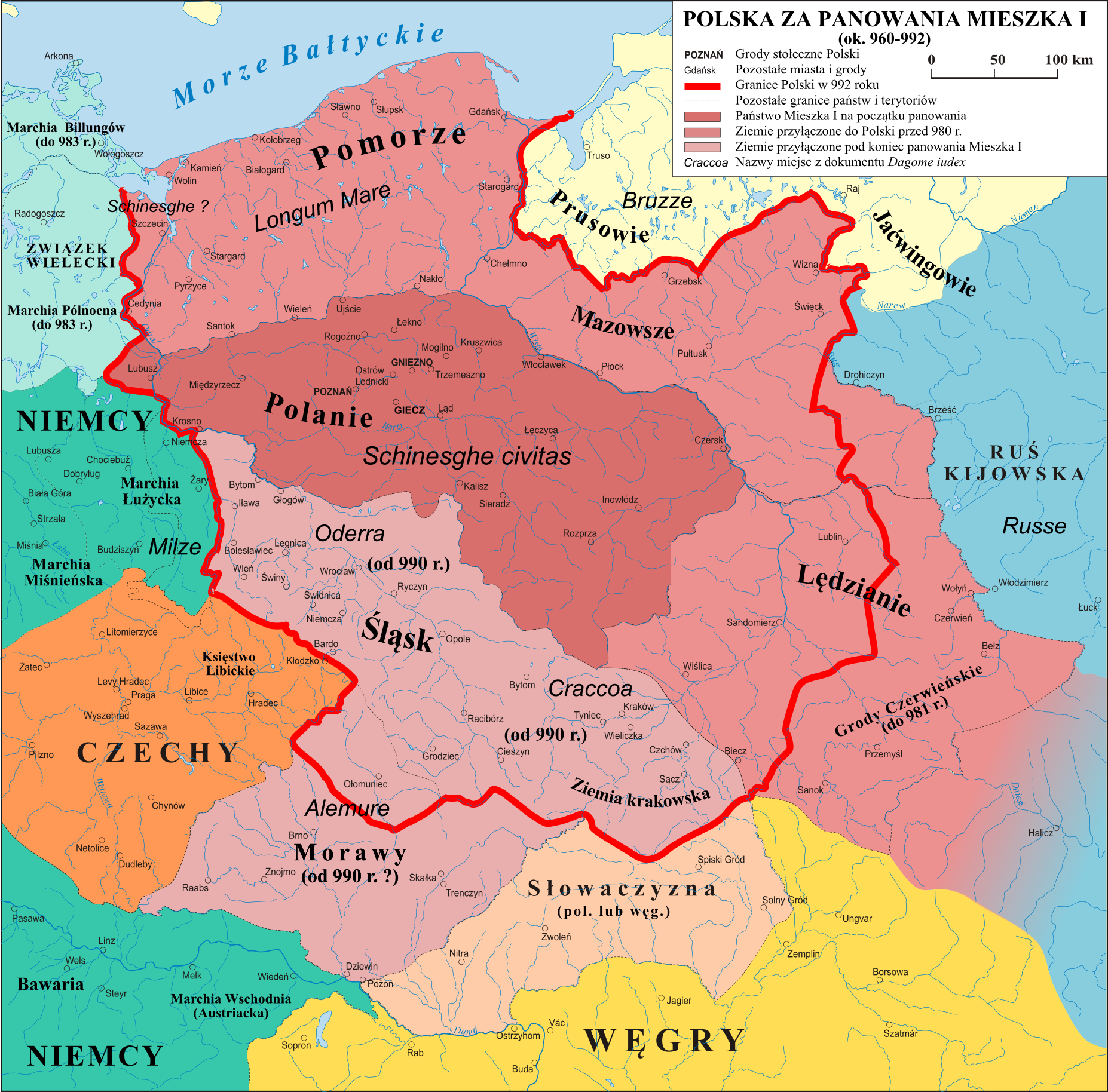|
West Prussia Province
The Province of West Prussia (; ; ) was a province of Prussia from 1773 to 1829 and from 1878 to 1919. West Prussia was established as a province of the Kingdom of Prussia in 1773, formed from Royal Prussia of the Polish–Lithuanian Commonwealth annexed in the First Partition of Poland. West Prussia was dissolved in 1829 and merged with East Prussia to form the Province of Prussia, but was re-established in 1878 when the merger was reversed and became part of the German Empire. From 1918, West Prussia was a province of the Free State of Prussia within Weimar Germany, losing most of its territory to the Second Polish Republic and the Free City of Danzig in the Treaty of Versailles. West Prussia was dissolved in 1919, and its remaining western territory was merged with Posen to form Posen-West Prussia, and its eastern territory merged with East Prussia as the Region of West Prussia district. West Prussia's provincial capital alternated between Marienwerder (present-day Kwidzyn, ... [...More Info...] [...Related Items...] OR: [Wikipedia] [Google] [Baidu] |
Provinces Of Prussia
The Provinces of Prussia () were the main administrative divisions of Prussia from 1815 to 1946. Prussia's province system was introduced in the Prussian Reform Movement, Stein-Hardenberg Reforms in 1815, and were mostly organized from duchies and historical regions. Provinces were divided into several , sub-divided into ''Districts of Prussia, Kreise'' (districts), and then into ''Gemeinde (Germany), Gemeinden'' (townships) at the lowest level. Provinces constituted the highest level of administration in the Kingdom of Prussia and Free State of Prussia until 1933, when Nazi Germany established ''de facto'' direct rule over provincial politics, and were formally abolished in 1946 following World War II. The Prussian provinces became the basis for many States of Germany, federal states of Germany, and the states of Brandenburg, Lower Saxony, and Schleswig-Holstein are direct successors of provinces. History Following the dissolution of the Holy Roman Empire in 1806 and the Congress ... [...More Info...] [...Related Items...] OR: [Wikipedia] [Google] [Baidu] |
Free State Of Prussia
The Free State of Prussia (, ) was one of the States of the Weimar Republic, constituent states of Weimar Republic, Germany from 1918 to 1947. The successor to the Kingdom of Prussia after the defeat of the German Empire in World War I, it continued to be the dominant state in Germany during the Weimar Republic, as it had been during the empire, even though most of Territorial evolution of Germany#Territorial changes after World War I, Germany's post-war territorial losses in Europe had come from its lands. It was home to the federal capital Berlin and had 62% of Germany's territory and 61% of its population. Prussia changed from the authoritarian state it had been in the past and became a parliamentary democracy under its Constitution of Prussia (1920), 1920 constitution. During the Weimar period it was governed almost entirely by pro-democratic parties and proved more politically stable than the Republic itself. With only brief interruptions, the Social Democratic Party of Germ ... [...More Info...] [...Related Items...] OR: [Wikipedia] [Google] [Baidu] |
Pomesanians
Pomesanians were a Old Prussians, Prussian clan. They lived in Pomesania (; ; ), a historical region in modern northern Poland, located between the Nogat and Vistula Rivers to the west and the Elbląg River to the east. It is located around the modern towns of Elbląg and Malbork. As the westernmost clan, the Pomesanians were the first of the Prussians to be conquered by the Teutonic Knights, a German military crusading order brought to the Chełmno Land to convert the pagans to Christianity. Due to Germanization and assimilation, Pomesanians became extinct some time in the 17th century. Etymology The territory is said in folk etymology to have been named after Pomeso, a son of Widewuto, legendary chieftain of the Prussians. Georg Gerullis determined that its name was actually derived from the Old Prussian word , meaning ''fringe of the forest''. The Lithuanian term ''pamedė'', having the same meaning, was introduced by Kazimieras Būga. History The area was inhabited by Ba ... [...More Info...] [...Related Items...] OR: [Wikipedia] [Google] [Baidu] |
Old Prussians
Old Prussians, Baltic Prussians or simply Prussians were a Balts, Baltic people that inhabited the Prussia (region), region of Prussia, on the southeastern shore of the Baltic Sea between the Vistula Lagoon to the west and the Curonian Lagoon to the east. As Balts, they spoke an Indo-European languages, Indo-European language of the Baltic languages, Baltic branch now known as Old Prussian language, Old Prussian and worshipped pre-Christian Prussian mythology, deities. Their ethnonym was later adopted by predominantly Low German language, Low German-speaking inhabitants of the region. The duchy of the Duchy of Poland (c. 960–1025), Polans under Mieszko I, which was the predecessor of the Kingdom of Poland (1025–1385), Kingdom of Poland, first attempted to conquer and baptize the Baltic tribes during the 10th century, but repeatedly encountered strong resistance. Not until the 13th century were the Old Prussians subjugated and their lands conquered by the State of the Teuton ... [...More Info...] [...Related Items...] OR: [Wikipedia] [Google] [Baidu] |
Masovians
Masovians, also spelled as Mazovians, and historically known as Masurians, is an ethnographic group of Polish people that originates from the region of Masovia, located mostly within borders of the Masovian Voivodeship, Poland. They speak the Masovian dialect of Polish.G. Odoj, A. Peć: ''Dziedzictwo kulturowe – edukacja regionalna''. ("Cultural heritage – regional education"), Dzierżoniów: Wydawnictwo Alex, 2000, p. 74, , . The group originates from the Lechitic tribe of Masovians, first referenced in the historical records by Nestor the Chronicler in the 11th century. In the Polish census of 2021, 97 people declared Mazovian national identity. Name The name Masovian, in Polish, ''Mazowszanin'', comes from the name of the region of Masovia, in Polish known as ''Mazowsze''. The name of the region, comes from its Old Polish names ''Mazow'', and ''Mazosze'', and most likely came from word ''maz'' (ancestor word of modern ''maź'' and ''mazać''), which was used to ... [...More Info...] [...Related Items...] OR: [Wikipedia] [Google] [Baidu] |
Pomerelia
Pomerelia, also known as Eastern Pomerania, Vistula Pomerania, and also before World War II as Polish Pomerania, is a historical sub-region of Pomerania on the southern shore of the Baltic Sea in northern Poland. Gdańsk Pomerania is largely coextensive with Pomerelia, but slightly narrower, as it does not include Chełmno Land or Michałów Land. Its largest and most important city is Gdańsk. Since 1999 the region has formed the core of Pomeranian Voivodeship. Overview Pomerelia is located in northern Poland west of the Vistula river and east of the Łeba river, mostly within the Pomeranian Voivodeship, with southern part located in the Kuyavian-Pomeranian Voivodeship and small parts in West Pomeranian Voivodeship. It has traditionally been divided into Kashubia, Kociewie, Tuchola Forest and Chełmno Land (including the Michałów Land, sometimes with the addition of Lubawa Land). The Lauenburg and Bütow Land is considered by Polish historiography a part of Kashubia ... [...More Info...] [...Related Items...] OR: [Wikipedia] [Google] [Baidu] |
Pomeranians (Slavic Tribe)
The Pomeranians (; ; ), first mentioned as such in the 10th century, were a West Slavic tribe, which from the 5th to the 6th centuries had settled at the shore of the Baltic Sea between the mouths of the Oder and Vistula Rivers (the latter Farther Pomerania and Pomerelia). They spoke the Pomeranian language that belonged to the Lechitic languages, a branch of the West Slavic language family. The name ''Pomerania'' has its origin in the Old Polish ''po more'', which means "Land at the Sea". Prehistory Following the exit of the Hamburgian hunters, the area was inhabited successively by Celts and the Wielbark Culture (Germanic tribes similar to the Goths and the Rugians). Groups of Slavs populated the area as a result of the Slavic migration. The Pomeranian tribes formed around the 6th century. There was also a Pomeranian culture, which was replaced by the Jastorf culture. From around the 6th century, West Slavic tribes migrated via the Vistula and Oder Rivers into the ... [...More Info...] [...Related Items...] OR: [Wikipedia] [Google] [Baidu] |
Lechites
Lechites (, ), also known as the Lechitic tribes (, ), is a name given to certain West Slavs, West Slavic tribes who inhabited modern-day Poland and eastern Germany, and were speakers of the Lechitic languages. Distinct from the Czech–Slovak languages, Czech–Slovak subgroup, they are the closest ancestors of ethnic Polish people, Poles and of Pomeranians (Slavic tribe), Pomeranians, Lusatians and Polabians. History According to Polish legend, Mieszko I inherited the ducal throne from his father who probably ruled over two-thirds of the territory inhabited by eastern Lechite tribes. He united the Lechites east of the Oder (Polans (western), Polans, Masovians, Pomeranians (Slavic tribe), Pomeranians, Vistulans, Silesians) into a single country of Poland. His son, Bolesław Chrobry, Bolesław I the Brave, founded the bishoprics at Wrocław, Kołobrzeg, and Kraków, and an archbishopric at Gniezno. Bolesław carried out successful wars against Bohemia, Moravia, Kievan Rus' and L ... [...More Info...] [...Related Items...] OR: [Wikipedia] [Google] [Baidu] |
Middle Ages
In the history of Europe, the Middle Ages or medieval period lasted approximately from the 5th to the late 15th centuries, similarly to the post-classical period of global history. It began with the fall of the Western Roman Empire and transitioned into the Renaissance and the Age of Discovery. The Middle Ages is the middle period of the three traditional divisions of Western history: classical antiquity, the medieval period, and the modern period. The medieval period is itself subdivided into the Early, High, and Late Middle Ages. Population decline, counterurbanisation, the collapse of centralised authority, invasions, and mass migrations of tribes, which had begun in late antiquity, continued into the Early Middle Ages. The large-scale movements of the Migration Period, including various Germanic peoples, formed new kingdoms in what remained of the Western Roman Empire. In the 7th century, North Africa and the Middle East—once part of the Byzantine Empire� ... [...More Info...] [...Related Items...] OR: [Wikipedia] [Google] [Baidu] |
Province Of Posen
The Province of Posen (; ) was a Provinces of Prussia, province of the Kingdom of Prussia from 1848 to 1920, occupying most of the historical Greater Poland. The province was established following the Greater Poland Uprising (1848), Poznań Uprising of 1848 as a successor to the Grand Duchy of Posen, which in turn was annexed by Prussia in 1815 from Duchy of Warsaw. It became part of the German Empire in 1871. After World War I, Posen was briefly part of the Free State of Prussia within Weimar Germany, but was dissolved in 1920 after the Greater Poland uprising (1918–1919), Greater Poland Uprising broke out and most of its territory was incorporated into the Second Polish Republic. The remaining German territory was re-organized into Posen-West Prussia in 1922. Posen (present-day Poznań, Poland) was the provincial capital. Geography The land is mostly flat, drained by two major drainage basin, watershed systems; the Noteć (German: ''Netze'') in the north and the Warta (''Wa ... [...More Info...] [...Related Items...] OR: [Wikipedia] [Google] [Baidu] |





